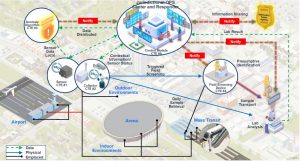
The Department of Homeland Security currently hopes to begin soliciting bids in fiscal year 2022 for a next-generation system to detect biological threats in major urban areas of the U.S. with the potential to field the Biological Detection for the 21st Century (BD21) system-of-systems as early as FY ’25, program officials said earlier this month. The BD21 program is conducting experimental technology demonstrations and is focused on developing an acquisition strategy, requirements and assessing technology, according to information presented at…

 By
By 











